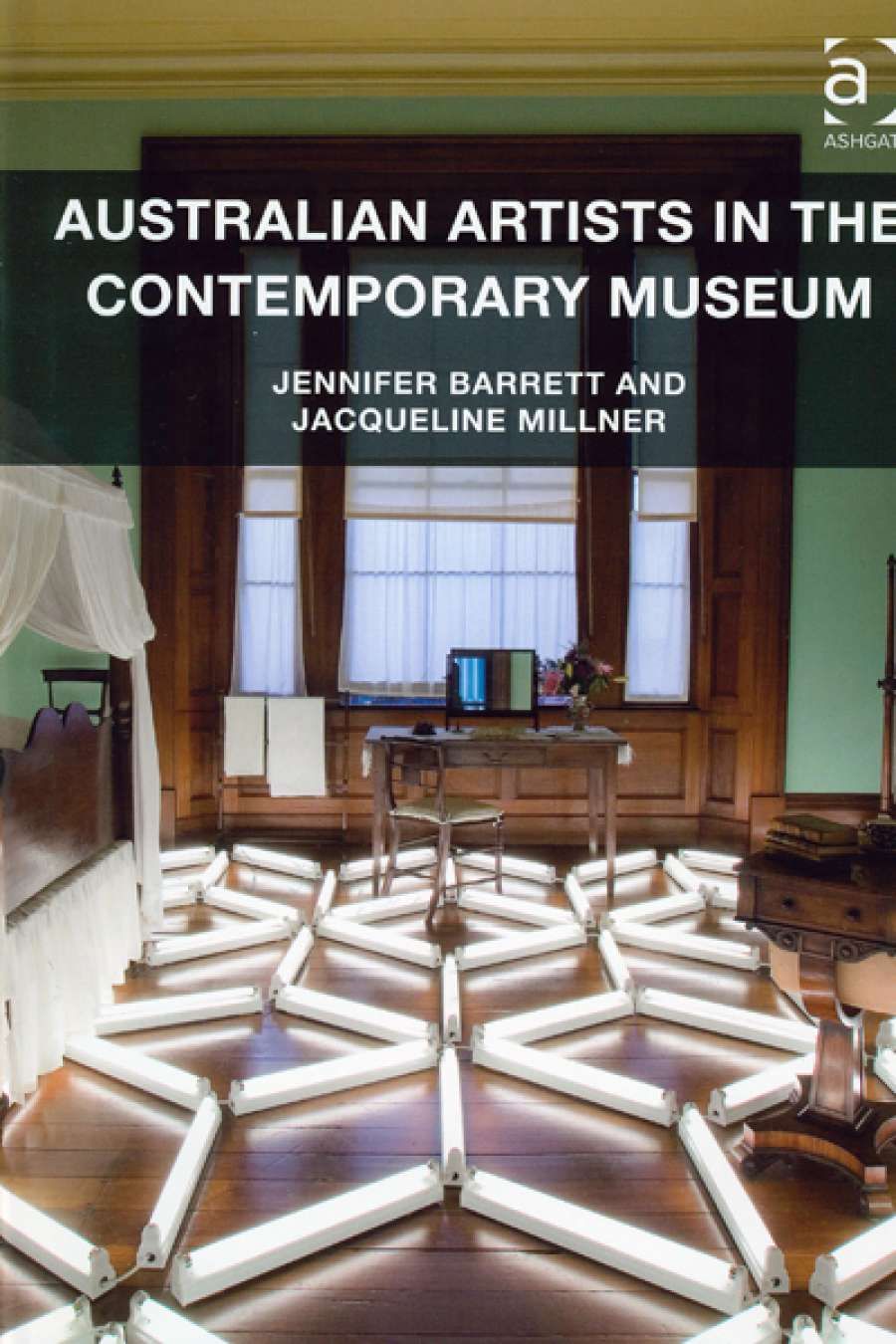
- Free Article: No
- Contents Category: Art
- Custom Article Title: Peter Hill reviews 'Australian Artists in the Contemporary Museum' by Jennifer Barrett and Jacqueline Millner
- Book 1 Title: Australian Artists in the Contemporary Museum
- Book 1 Biblio: Ashgate Publishing, $129.95 hb, 240 pp, 9781409442493
Fiona Hall, who will be representing Australia at the 2015 Venice Biennale, has worked exhaustively across museums, non-fine art museums and gardens. In Folly for Mrs Macquarie (2000), part of the City of Sydney’s sculpture walk, Hall used representations of the bones of animals driven from the site by white settlement, alongside the Macquarie family crest of a raised dagger in a clasped hand. ‘We certainly got visitor feedback about this one,’ said Frank Howarth, director of the Royal Botanic Gardens. ‘It looks like a nice comfortable little belvedere, but when you look at the imagery, the belvedere’s dome is made of hack axes and barbed wire.’
Others whose work is discussed and illustrated include Brook Andrew, María Fernanda Cardoso, Anne Ferran, Fiona Foley, Nigel Helyer, Patricia Piccinini, Judy Watson, Anne Graham, Jayne Dyer, and Jo-Anne Duggan, to whose memory the book is dedicated by its two authors, Jennifer Barrett and Jacqueline Millner. The projects of several artists working as duos within museums are included, notably Claire Healy and Sean Cordeiro, Sherre DeLys and Joan Grounds, and Joyce Hinterding and David Haines. Other sections of the book look at ‘Institutional Practices and Artists’ Critiques’, ‘Post-colonial Engagements: Playing with History’, and ‘The Artist as Curator’.
‘‘‘The authors’’ central argument is that artists’ engagement with the museum has shifted from politically motivated critique taking place in museums of fine art, towards interventions taking place in non-art museums’
A few international artists, especially when exhibiting in Australia, are included, as are others working elsewhere. There is Mark Dion’s Systema Metropolis (2007), an over-the-top visual Wunderkammer at London’s Natural History Museum, and there is the ever-challenging and ground-breaking Fred Wilson and his Viewing the Invisible (1998) at the Ian Potter Museum of Art, an intervention that moved me profoundly when I came across it by chance. Wilson has worked with ideas about the representation – and employment, or lack of it – of African Americans in the museum system – notably, in Melbourne, placing a cleaner’s trolley on a white plinth with two coloured hands gripping its handle – in the same way that the late Gordon Bennett did with perceptions and historical readings of indigenous issues across Australia, and across time. And this book does cover the whole continent, from Jo Darbyshire’s controversial, myth-busting The Gay Museum (2003) at the Western Australian Museum in Perth to the collaboration between curator Melissa Lovett with artists Carolyn Eskdale and Louise Weaver at the University of Melbourne’s one-of-a-kind Grainger Museum. Eskdale, the authors tell us, ‘chose to work in the “London Room” filled with the dark Edwardian furniture that travelled with Percy and his mother Rose around various continents’, while Weaver ‘rearranged objects she chose from Grainger’s ethnographic collection amid her own works of taxidermy: animals whose hair, twine, crochet, and beading seemed to mimic Grainger’s own choice as collector’.
‘In Folly for Mrs Macquarie (2000), part of the City of Sydney’s sculpture walk, Hall used representations of the bones of animals driven from the site by white settlement’
Indeed, a quote from the great man himself, from 1941, can be seen as highly prescient in light of the content of this fascinating book: ‘Most museums, most cultural endeavours, suffer from being subjected to too much taste, too much elimination, too much selection, too much specialization! What we want is all-sidedness, side lights, cross-references.’
As Michael Goldberg says in the conclusion, ‘Now you can reel off the names of artists who have worked in museums: Boltanski, Wilson, Cripps in Australia, to the point where you might ask, has the museum been done? I maintain that it’s not over.’ I was delighted to see Patrick Pound’s immensely popular Gallery of Air, recently seen in Melbourne Now at the National Gallery of Victoria, footnoted – probably at the last minute, given publishing deadlines. And no book on this topic would be complete without David Walsh’s rule-breaking MONA. Crucially, Theatre of the World is covered, as is its curator Jean-Hubert Martin. One of the most sublime exhibitions (and shockingly under-reviewed) ever to be mounted in Australia, it contained 160 works from MONA and 300 from the Tasmanian Museum and Art Gallery, before moving to La Maison Rouge in central Paris, where I just managed to catch it because its run had been extended by two weeks due to popular demand.


Comments powered by CComment